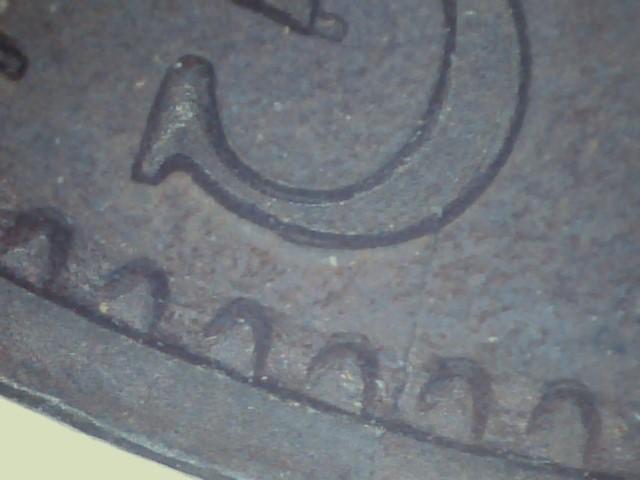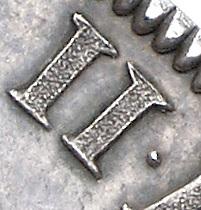-
Posts
12,743 -
Joined
-
Last visited
-
Days Won
339
Content Type
Profiles
Forums
Events
Downloads
Store
Gallery
Articles
Everything posted by Rob
-
And another one. 1864 crosslet. Again a different number of teeth. Given the last digit was added later, surely all dates should have multiple varieties of widths even if they aren't listed? And does anybody care, or is it only for specific dates?
-
How common or rare is BP1882Ha given it isn't in Freeman or Spink which only list the 2/1? And a second question. How many date widths are there for 1869? I've got an 11.5 here and Gouby only lists 10.5
-
Still costs you to post the item and it's not as if they will learn from the mistake.
-
Seems like a waste of money. What are the odds on them getting it right the next time, or a second, third etc time I they disagree with your assessment.
-
The flaw on the KH23 isn't very prominent. It's more obvious from the rim to the G, but thinner as it leaves the G and heads for the truncation in a gentle arc to the right. That is the only difference between KH22 and KH23 and arguably is just a late stage 22 not worthy of a separate number. To differentiate KH16 & KH22, the first has a flaw under the armpit and SOHO is in line. The second has no flaw and the second O is lower. The flag on the ship is also smaller on the latter die.
-
I'd go 1244, but would prefer bigger pictures.
-
I've got list 44 here, but it's problematic in that the page is too long to fit the scanner, and there are 52 pages. There's no easy way to get a copy to you unless I physically photograph the lot, but then the pages won't be a consistent size.
-
Given the fact it is impossible to reconcile some overpunches, even the seemingly impossible/improbable cannot be ruled out. If the wrong punch was used, you could get any possible combination in any year as any punch (including letters) could be used. Most of the time the correct character punch would inevitably be used, but this can't be guaranteed. e.g. a 9 instead of an 8 is only a case of picking a punch from the adjacent bin, or choosing one that was replaced in the wrong bin. All options must be on the table.
-
I think it is important to keep all options on the table, even the improbable. When you already have 8/2, 8/3, 8/6 and 8/7 as accepted variants, there is nothing to exclude the possibility of 8/4 and 8/5 also coming into the equation. At a time when they were clearly reusing every available die, it is also not inconceivable that an 1840s obverse could have been repurposed if they found one. Probably not relevant if all they wanted to keep was an example of the ww and no ww dies, but FWIW Hocking only lists the 18- die and an 1859.
-
There is always the option of an 1854 die filled and recut with a 9 punch before the mistake was recognised and corrected with an 8. That would keep everyone happy.
-
And a comparison between this 8 and a halfpenny 9. It's a very good fit, particularly the distance between the knob and the arc at the top inside the lower loop.
-
-
I was hoping someone might have come to a conclusion since it was last discussed. The first thing I had considered in hand was a 4 as a possibility based on relief, but looking from multiple angles I am on balance still inclined to the halfpenny 9 punch theory. In the absence of the right digital skill set for drawing lines and annotating, I'll print off a picture and mark it up to demonstrate what I mean.
-
Need a better picture
-
Thoughts please. There is also a raised line crossing the bottom loop just below half way - just visible. Intriguingly it stops halfway across the left hand section of the loop
-
A bit left field this, but trying to grope through the murk I wonder if all this was an attempt by Putin to preempt a coup (real or imagined) or similar, as there's an awful lot that doesn't add up militarily. Clearly the invasion of Ukraine was and is an existential problem for that country, but is equally so for Putin. He can't afford to lose or he is toast, so what drove the man to order an attack when it wasn't necessary and carried risks for his entire empire. The question therefore is why did he invade when the army was so obviously unprepared for a war? This is the real conundrum because he might be a psycopath, but he isn't stupid. The accusations of widespread genocide and Ukrainian attacks on ethnic Russians are patently fictitious to all, so what caused him to need a pretext for going in? After all, armies do not decide to invade a neighbour on a whim because these things take weeks and months of meticulous planning, yet here we are with soldiers apparently expecting to go for an afternoon walk and an army with no apparent sensible logistics organisation, this despite the fact they had just been on exercises - which are precisely what you use to iron out problems and join the dots. The whole episode is suggestive of a snap decision by Putin with no input from his generals, two or three of which have been dismissed and arrested in the last month, though I don't know how many are retired in this manner on a regular basis. Whatever the failings of the Russian army in terms of delegating decisions downwards to the man on the ground, it beggars belief that the generals would be collectively blind to the planning necessities of a military campaign. which again points to a decision about which they were not consulted. To paraphrase Lady Bracknell, 'To lose one general may be regarded as a misfortune. To lose seven looks like carelessness.' Estimates of Russian casualties are speculative, but a US estimate says around the 7K mark. Too lose 7 group commanding generals, not to mention a significant number of officers commanding the various constituent units of these groups from such a low total just doesn't make sense. Even if the overall losses were 50% higher, it would still seem like a stitch up. I think something spooked him because the Russians had 7 or 8 years of experience dealing with the Ukrainian military in the east and even with Russian backing on the ground in Donetsk and Luhansk the separatists had ground to a halt. Why did he take the risk that threatened his position?
-
If we all agree there is no right or wrong way to collect, then by extension, it is not wrong to slab a 1942 florin. I wouldn't and you wouldn't , but that doesn't make them wrong. It is their choice to waste their own money.
-

The Tyrant collection
Rob replied to PWA 1967's topic in British Coin Related Discussions & Enquiries
The position of the plug would correspond to the small round spot of slightly different colour immediately to the left of the F(R), again supportive of the theory, though with the caveat that I haven't seen the coin in hand. -

The Tyrant collection
Rob replied to PWA 1967's topic in British Coin Related Discussions & Enquiries
-

The Tyrant collection
Rob replied to PWA 1967's topic in British Coin Related Discussions & Enquiries
No it's not. The Slaney coin was bought by Geoff Cope and is vastly superior to this one. This is the ex Norweb coin which Roddy had for a while before selling it in one of the NY sales. This is Bergne no.7 (NC 1855) which was described as: No. 7. Abraham Edmonds (bought by him casually), Thomas Dimsdale. Bought at his sale in 1824, for 110, by Thomas Thomas. do. 1844, for 48, by The late James Dodsley Cuff. (In a very good state ; but there is scratched on the field of the obverse, C. W., Oct. 12, 1799.") You can see traces of where the graffiti was subsequently polished out. However, in my view and that of others, it has also been plugged, which goes a long way to explaining how a dealer could pick it up so cheaply relative to other offerings around the end of the 18th century. If you look at II in the obverse legend, the facing uprights of the two characters are defective at the top giving a rounded profile to the vertical line. Compare that with the Slaney, Glenister or any other coin and these have perfectly formed Is. The Slaney coin wasn't known to Bergne, so doesn't appear on his list. CW may well be the initials of the jeweller or silversmith on the Strand that Edmonds acquired the coin from. Graffiti on a holed coin is not much more of an impediment to value, so this may be the coin that someone was touting around the 1740s but struggled to sell. Can't find the relevant document at the moment to give a name. Discuss. -

The Tyrant collection
Rob replied to PWA 1967's topic in British Coin Related Discussions & Enquiries
Yes, as I have first hand experience. The Henry VII half angel is a Montagu plate coin. I was hoping it might slip under the radar when it came up a few years ago, as it is only in an AU slab. It was only me and him, but I gave up when it went multiples of book. A bit p'd off though as I thought beforehand there was a realistic chance of getting it. It's a pity he doesn't collect MS65s or better only. -
The wife and I had this discussion a couple of years ago when China started playing hardball in Hong Kong and decided if there was a forced mass exodus we would put someone up. The same would apply today, but currently have a problem in that 2 offspring are temporarily living here, so no free room at present. Personal privacy doesn't really come into it. They would want to move to a more stable environment asap where there was room to swing a cat in any case, so it wouldn't likely last more than a few months. When the shit really hits the fan, there's a moral obligation to do whatever you can to help.
-
I'm not convinced about that as there is too much excess metal beyond the teeth to account for just the rim.
-
-
Thoughts please chaps. Is not a cast as it rings clearly. The legend looks to be the correct size and font. The diameter of the design is correct for a penny Is made of copper or bronze. Weighs 9.38g and the flan is about 1.5mm thick, but obviously suffers from a little corrosion. The irregularity of the edge and diameter would tend to eliminate it being struck out of collar because the blank would be round when punched out from the rolled sheet. The die axis is correct









.png.ec1af1bd4bb92d5fb54b352b9bb63264.png)

